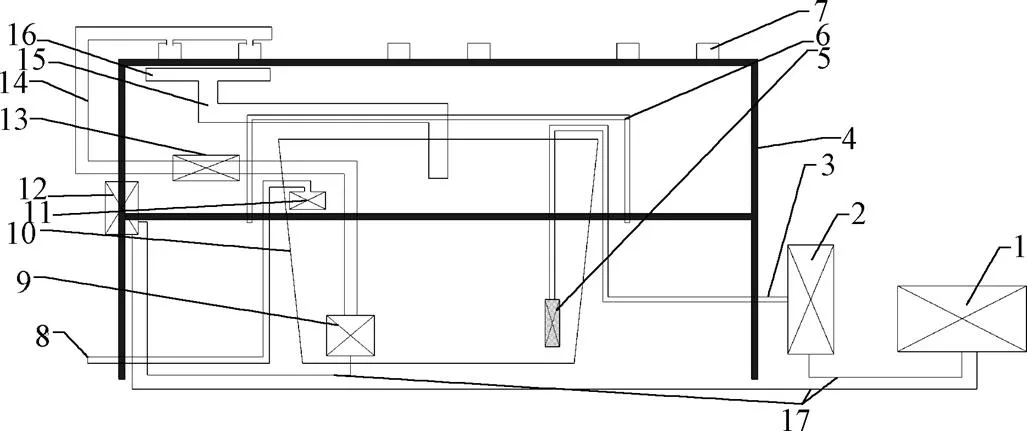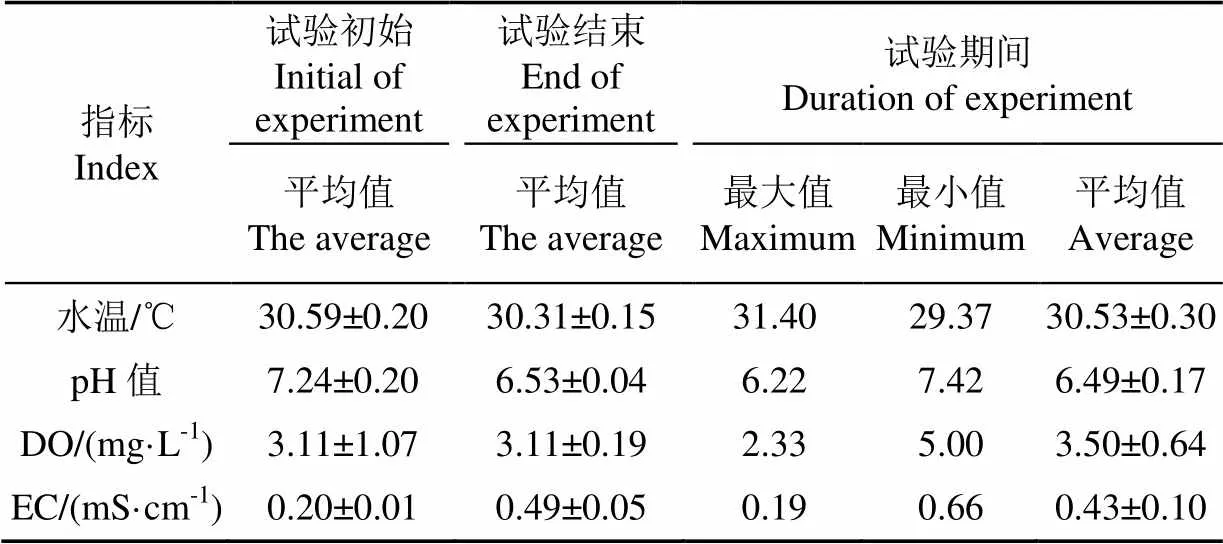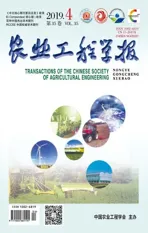种植密度对鱼菜共生系统氮素转化的影响
2019-03-28蔡淑芳陈永快包兴胜雷锦桂
蔡淑芳,陈 敏,陈永快,包兴胜,张 钟,雷锦桂
种植密度对鱼菜共生系统氮素转化的影响
蔡淑芳,陈 敏,陈永快,包兴胜,张 钟,雷锦桂※
(福建省农业科学院数字农业研究所,福州 350003)
为评估不同植物密度对鱼菜共生系统氮素转化的影响,在试验温室内搭建了基于营养液膜(nutrient film technique,NFT)栽培的鱼菜共生系统。养殖水量350L,养殖密度10 kg/m3;栽培面积1.0 m2,栽培密度60、45和30株/m2。考察了系统33d运行期间的水质情况和鱼菜生长情况,探讨了投入氮素的转化情况以及时间和植物密度对氮化合物质量浓度的影响情况。结果表明:试验期间,不同植物密度系统的水质适合鱼菜生长,鱼类和蔬菜主要生物学特性指标有不同程度的增长。氨氮、亚硝酸盐氮、硝酸盐氮质量浓度随时间变化显著(<0.01);不同植物密度系统的硝酸盐氮质量浓度存在显著差异(=0.028),植物密度为45株/m2的系统具有较高的硝酸盐氮积累优势。系统运行后期,氮化合物质量浓度基本稳定,氨氮、亚硝酸盐氮、硝酸盐氮质量浓度分别为2.50、0.20和5.00 mg/L左右。49.32%~68.41%投入饲料的氮素积累在鱼菜生物体内,与普通水产养殖和NFT栽培相比,鱼、菜含氮量均不具优势。可通过扩大栽培面积、配备生物滤池、调整栽培模式等方法加强氮素转化。综上,试验系统的优势栽培密度为45株/m2,应结合其他措施提升氮素转化效果。
养殖;氮素;鱼菜共生;植物密度
0 引 言
鱼菜共生是水产养殖与无土栽培的互利结合,具有零排放特征[1]。在鱼菜共生系统中,鱼类排泄废物,细菌将废物转化成营养以供植物吸收。这形成了动植物的集约化生产,降低了种养殖独立系统的操作成本,减少了污水排放,节约了用水量,因此被认为是一种可持续的生产模式[2]。
鱼菜共生系统的研究始于20世纪70年代,相关研究范围非常广泛,包括作物、鱼类、每日喂食量比例的合理化,生物过滤器的类型[3-6],植物的水质净化、修复作用等方面[7-13]。近年来,有学者以鲤鱼/罗非鱼-油菜/番茄/白菜等为研究对象,在实验室规模的系统中进行了鱼菜共生系统氮素转化的系列研究,包括系统设计(如藻类-细菌型系统、不同植物种类系统、水流速度)、运行条件(如温度、pH值、溶解氧、营养元素)、微生物群落调控(如硝化剂添加和填料分级)等多角度分析,并提出了相关的系统优化措施[14-25]。
虽然鱼菜共生系统氮素转化研究取得了一定的进展,但是因氮素转化是一个复杂的过程,涉及到氨化作用、硝化作用、反硝化作用等多元反应,影响因素众多,已有研究还不够全面。其中,从植物密度角度对鱼菜共生系统氮素转化的研究还鲜见报道[26]。不同植物密度的配置隶属于系统设计内容,植物密度关系到鱼菜比例、植株光照利用等,影响到植物氮素等营养吸收,进而作用于系统水质和鱼菜产出。因此,分析植物密度与系统氮素转化关联性具有重要意义。本研究拟在统一氮输入量情况下,深入研究植物密度在鱼菜共生氮素转化中所扮演的角色,探讨优势种植密度及其作用机理,为优化系统设计与运行等提供科学依据和技术指导。
1 材料和方法
1.1 试验装置
试验于福州的中以示范农场内展开,试验基地为薄膜日光温室,接受自然光源直接照射,配置有卷帘、湿帘等环境控制设施。试验期间,室内空气湿度为51%~72%,室温为32.5~34.5 ℃。
温室内,一系列鱼菜共生系统整齐排列成3行,每个系统主体包含1个鱼箱和2根栽培槽(图1)。鱼箱采用容积为500L的PVC材质周转箱,上口径为1 m×1 m,下口径为0.85 m×0.85 m,高为0.7 m。栽培槽为营养液膜(nutrient film technique,NFT)栽培槽,每根栽培槽尺寸为6.50 m×0.07 m×0.05 m(长×宽×高),有35个定植孔,2根栽培槽间距18 cm,栽培面积为1 m2。鱼箱置于地面上,配有遮阴网,以防鱼跃出,并起到遮光作用,控制藻类生长。栽培槽置于距地面80 cm的NFT支架上。
除鱼箱和栽培槽外,每个鱼菜共生系统包含抽水泵、增氧机、过滤器及水气输送管等构件。鱼菜共生系统采用连续流运行,抽水泵将养殖水体提升并经过滤器过滤后输送至栽培槽内。水体滴滤进入蔬菜根部,流经整根栽培槽后于出水口流出,在重力作用下回流至鱼箱。增氧机用于补充系统的溶解氧。在水体循环过程中,蔬菜根部充当生物滤池,为微生物附着生长提供环境,对有机废水进行资源化处理与利用。试验期间,除用自来水补充因蒸发、植物蒸腾而损失的水量,系统与四周环境无水体交换。整套系统试验水流量为0.043 2 m3/h,循环率为20次/d,栽培区水流速约为3.45 m/min,停留时间为20 min。

1.电源装置 2.增氧机 3.导气管 4.栽培支架 5.曝气头 6.遮阳网 7.栽培槽 8.进水管 9.抽水泵 10.鱼箱 11.浮球液位开关 12.控制器 13.过滤器 14.输液管 15.集液槽 16.回液管 17.电线
1.2 试验设计
试验开始于2017年7月14日,结束于8月15日,试验期为33 d。试验设3个处理,每个处理3个重复。每个处理组蔬菜栽培面积为1.0 m2,A、B、C组栽培密度分别为60、45和30株/m2;养殖水量为350 L,养殖密度为10 kg/m3。
选用水雍菜()为水培植物,其根系发达,适于NFT栽培,且对水中氮等营养盐吸收去除能力强[8]。植株幼苗取自中以示范农场,试验开始前,所有植株均已在NFT槽上定植10 d。选取植株健康、生长状况基本一致的幼苗均匀移植至栽培槽内。
选用鲫鱼()为养殖鱼类,鲫鱼是优良的饲养品种,具有很强的适应能力,生长速度快且容易获取[27]。用于试验的鲫鱼初始质量为175~230 g,每个鱼箱的鲫鱼总质量约为3.5 kg。每日投饵2次,日投喂量为鱼总质量的2%[28]。养殖饵料选用市售蛋白质含量30%,含水率10%的漂浮型饵料。
1.3 试验方法
试验期间,对系统水质进行持续监测,使用HANNA的溶氧仪和一体化测试仪,每日现场测量鱼箱基础水质(水温、溶解氧DO、pH值、EC)。每4 d对含氮化合物(氨氮(NH4+–N)、亚硝酸盐氮(NO2––N)和硝酸盐氮(NO3––N))进行取样测定,取样点为鱼箱,取样时间为上午9:00。采集的水样于24 h内完成测试,水质分析主要参考国家标准方法。氨氮:纳式试剂分光光度法[29],亚硝酸盐氮:分光光度法[30],硝酸盐氮:紫外分光光度法[31]。
试验期间,每日记录饵料投放量和水体补充量;并根据水雍菜的生长状况,进行3次收割(第9、21、33天),每次收割时剪去水雍菜上部茎叶部分,保留根部继续生长。
试验起止时,取样测量水雍菜株高、鲜质量和鲫鱼体长、鲜质量。测定试验起止和收割期的鱼菜生物体总氮含量,测定方法为凯氏定氮法。
1.4 试验分析
相对增长率计算方法如下
=100%×(2j−1j)/1j
式中为相对增长率;1j2j为试验开始和结束时的第种类型鱼菜生物学特性指标(鲜质量(g)、总鲜质量(kg)、体长(cm)、株高(cm)、含氮量(%)、氮积累总量(g))。
采用SPSS16.0数据处理软件进行方差分析,用Excel作图。
2 结果与讨论
2.1 基础水质情况
试验初始按照设计的系统水量加入自来水,系统循环运行33 d,期间不进行换水,试验期内各项基础水质指标的情况如表1所示。试验期间系统的水温稳定,平均水温为30.53 ℃;水质基本中性,平均pH值为6.49;经曝气增氧,平均DO为3.50 mg/L;平均EC值为0.43 mS/cm。

表1 基础水质情况
有研究表明,鲫鱼在0~40 ℃都可生存,最佳生长水温为25~30 ℃,DO为0.7~7 mg/L,pH值为6~9[27]。水雍菜生长适温为25~30 ℃,能耐35~40 ℃的高温,最适pH值为5.6~7.0[32]。因营养物质产生的可持续性,在鱼菜共生系统中,EC保持在0.3~0.6 mS/cm比较理想[3]。由此可知,在试验水质条件下,鲫鱼和水雍菜均能正常生长。
2.2 鱼菜的生物学特性
试验期间,鱼菜(总)鲜质量、体长、株高等均有正向的相对增长(表2)。A、B、C组每条鲫鱼鲜质量增加91.67、83.33、93.33 g,总鲜质量增加1.69、1.50、1.65 kg,体长增加3.13、3.17、4.27 cm,期间投加饵料总计2.31 kg。期间共收割3次水雍菜,合计A、B、C组每株水雍菜鲜质量增加128、137、135 g,总鲜质量增加7.71、6.15、4.04 kg,株高增加104.66、103.88、105.01 cm。经单因素方差分析,植物密度对鱼菜(总)鲜质量、体长、株高相对增长率的影响不显著(>0.050);植物密度对菜总鲜质量增量影响显著(<0.01)。

表2 鱼菜生物学特性
注:不同小写字母表示处理间差异显著(<0.05)。A,B,C处理分别指蔬菜的种植密度为60、45和30株·m-2. 下同。
Note: Different lowercase letters in the table indicate significant differences between treatments (<0.05)。The plant density of A, B, C treatment are 60,45 and 30 plants·m-2. The same as below.
饲料含氮是系统氮素增加的主要来源,经转化后氮素主要存在鱼菜生物体内。试验主要考查了饲料含氮向鱼菜生物体的氮素转化,N2O、N2等形式的氮素遗失不在本试验范围内。试验期间,A、B、C组鱼、菜含氮量在8%、3.5%左右,相对增长率在7%以内;鱼、菜氮积累总量相对增长率为34.51%~45.10%、8.21%~9.69%。系统饲料投喂总量均为2.31 kg,按照粗蛋白质含氮量为16%计算,饲料含氮共99.79g。A组饲料含氮的32.90%、35.51%;B组饲料含氮的25.00%、28.70%;C组饲料含氮的31.06%、18.26%,分别转化为鱼、菜氮积累总量。经单因素方差分析,植物密度对菜氮积累总量增量影响显著(=0.002);植物密度对鱼菜含氮量和氮积累总量的相对增长率没有显著影响(>0.050)。
试验结果表明,不同植物密度的菜总鲜质量增量、菜氮积累总量增量有显著差异,植物密度与二者之间呈正相关。这说明,在栽培面积相同的情况下,更大的栽培密度将收获更多的水雍菜产出和氮积累,这可以由植株数量优势加以解释。在养殖密度不变的前提下,通过增加植物栽培面积来积累更多蔬菜和氮产出或许是可取的。
相比于普通水产养殖和NFT栽培,鱼菜共生系统可以产出鱼菜2种经济作物,氮素利用率提高[18]。试验结果表明,约49.32%~68.41%投入饲料的氮素积累在鱼菜生物体内。虽然鱼菜氮积累总量均有正向增长,但鱼菜含氮量主要为负增长,与普通水产养殖和NFT栽培相比[33-34],鱼菜含氮量不具优势。含氮量是评价生物体养分吸收的重要指标之一[35],含氮量负增长说明系统中鱼菜对氮素吸收处于相对劣势,这反映了系统的氮素转化效率还有进一步提升的可能。有研究表明,不同于基质栽培,NFT栽培由于没有用于附着微生物的砾石等基质[23],基于NFT栽培的鱼菜共生系统需要配备独立的用于硝化反应的生物滤池[36],否则将降低氮素转化效应。本试验仅将植物根部充当生物滤池使用,在后期的试验中,可通过改进NFT栽培模式,如配置独立的生物滤池或者应用基质栽培方法等予以调整。
2.3 氮化合物质量浓度规律
在33d试验中,3种氮化合物质量浓度随时间的变化情况如图2所示。

图2 氮化合物质量浓度曲线
由图2可知,氨氮质量浓度波动较大,在系统运行初期,氨氮质量浓度迅速升高,第5天达到峰值2.17 mg/L;而后经小幅下降后,于第9天开始又稳步上升,第21天达到峰值3.50 mg/L;系统运行后期经短暂下降后保持小幅增长,并趋向稳定。亚硝酸盐氮质量浓度总体呈下降趋势,在系统运行初期,亚硝酸盐氮质量浓度呈增长态势,第5天达到峰值1.39 mg/L;而后急剧下降,第21天达到低值0.20 mg/L;系统运行后期经小幅降低后保持低值发展。硝酸盐氮质量浓度上升趋势明显,在系统运行初期,硝酸盐氮质量浓度先缓慢后急剧增加,第13天达到峰值4.85mg/L;而后经短暂调整后于第21天开始保持持续增长,并趋向平稳。
方差分析显示,3种氮化合物质量浓度随时间变化显著(<0.01);不同种植密度的硝酸盐氮质量浓度差异显著(=0.028),不同种植密度的氨氮、亚硝酸盐氮质量浓度差异不显著(>0.050)。
有研究表明,在养殖水体资源化利用过程中,尽管有植物的吸收作用,但微生物的硝化反硝化仍然是主要的作用机制[37];生物滤器在处理有机污水时,本身具有一定的波动性[38]。在本试验中,分析如下:系统建立初期的1~5天,鱼类消耗含氮饲料,排放氨氮,亚硝化细菌开始发挥作用,能够氧化以获得能源固定无机碳,但同时存在着硝化细菌不足,不能及时将亚硝酸盐氮转化为硝酸盐氮的情况,因而表现为水体中氨氮质量浓度迅速升高,亚硝酸盐氮质量浓度上升较快,而硝酸盐氮质量浓度增加相对滞后。系统运行第5~9天,充当生物滤池的水雍菜根部中硝化细菌已经适应环境,能够迅速将氨氮转化为亚硝酸盐氮,并转化为硝酸盐氮,即表现为氨氮和亚硝酸盐氮质量浓度快速下降,以及硝酸盐氮质量浓度的稳步上升。系统运行第9~21天,硝化细菌仍然发挥着硝化作用,持续将氨氮转化为可供蔬菜吸收的硝酸盐氮,表现为亚硝酸盐氮质量浓度的下降和硝酸盐氮质量浓度的上升。21天后,系统运行基本稳定,硝化作用持续进行,系统内无亚硝酸盐氮质量浓度的积累,氨氮和硝酸盐氮质量浓度增加缓慢。系统运行期间,同时存在反硝化作用,硝酸盐氮、亚硝酸盐氮被转化为N2O、N2等气体。这有助于去除水体中氮素,减少对鱼类的影响,但造成了系统的氮遗失,不利于提高氮素利用效率[36]。
养殖水体中氨氮、亚硝酸氮的积累会影响鱼的生理状况,严重时致使鱼类死亡[15];而硝酸盐氮质量浓度即使高达150~300 mg/L,也对鱼类无害[37];且硝酸盐氮是鱼菜共生系统最重要的营养物质,其积累可促进植物的生长[18]。因此,保障鱼菜共生系统运行的关键是控制水体中氨氮、亚硝酸氮质量浓度。著名的运转良好的美国维尔京群岛大学(university of the virgin islands,UVI)鱼菜共生系统,氨氮、亚硝酸盐氮、硝酸盐氮质量浓度分别为1.6~2.9、0.4~1.1和54.7 mg/L[3]。在本试验的运行后期,系统氨氮、亚硝酸盐氮、硝酸盐氮质量浓度为2.50、0.20和5.00 mg/L左右,在鱼类可接受范围内,不影响鱼类正常生长。试验期间不同处理组的硝酸盐氮质量浓度差异明显,且B组硝酸盐氮质量浓度平均值最高。分析原因,可能是B组水雍菜栽培密度适中,植株数量较合适,通风透光性能较好,微生物生长环境较适宜,植株光照利用更充分,更有利于氨氮向硝酸盐氮的转化。
在鱼菜共生系统中,植物有优先吸收硝酸盐氮的趋势,因为鱼菜共生系统的硝酸盐氮质量浓度高于氨氮质量浓度[37];本试验结果证明了这种趋势的存在,但水雍菜对硝酸盐氮与氨氮的具体吸收差异还有待进一步研究。在系统运行后期,氨氮质量浓度处于2.5 mg/L左右,高于宋红桥等的研究结果[39];这可能是因为本研究采取了10 kg/m3的高密度水产养殖方式,由此造成饵料投喂量、水体含氮有机物和氨氮排放量的增加。在养殖密度固定的前提下,或许可以通过增加植物栽培面积来调节氨氮排放。本研究的氨氮、亚硝酸盐、硝酸盐氮浓度最高值低于邹艺娜等的研究结果[18];其中,在邹艺娜等的研究中,系统运行后期,硝酸盐氮浓度达30 mg/L以上,这可能是因为其采取的是基质栽培,本研究采取的是NFT栽培,栽培区水停留时间较短导致本研究的氮素转化效果欠佳。
3 结 论
1)试验期间,系统水质适合鱼菜正常生长,鲫鱼和水雍菜主要生物学特性指标有不同程度的增长。
2)大部分投入氮素经转化后在鱼菜生物体内积累,与普通水产养殖和营养液膜(NFT)栽培相比,试验后期鱼菜共生系统的鱼菜含氮量不具优势,氮素转化效率还有待提高。
3)氮化合物质量浓度随时间变化显著;种植密度为45株/m2的系统,有利于硝酸盐氮积累。试验后期氮化合物质量浓度基本稳定,可通过扩大栽培面积、配备生物滤池、调整栽培模式等方法加强氮素转化。
[1] Rakocy J E, Hargreaves J A. Integration of vegetable hydroponics with fish culture: A review[M]//Wang J K. Techniques for Modern Aquaculture. St.Joseph, Michigan, USA: American Society of Agricultural Engineers, 1993: 112-136.
[2] Licamele J. Biomass Production and Nutrient Dynamics in An Aquaponics System[D].Tucson, Arizona: University of Arizona, 2009.
[3] Rakocy J E, Masser M P, Losordo T M. Recirculating aquaculture tank production systems: Aquaponics-integrating fish and plant culture[R]. Stoneville, Mississippi: Southern Regional Aquaculture Center, 2006.
[4] Wilson L. Aquaponic system design parameters: Fish to plant ratios (feeding rate ratios)fact sheets [R]. Victoria, Australia: 2012.
[5] Buzdy K M, Lin L S. Scaling aquaponic systems: Balancing plant uptake with fish output[J]. Aquacultural Engineering, 2014, 63: 39-44.
[6] Lam S S, Ma N L, Jusoh A, et al. Biological nutrient removal by recirculating aquaponic system: Optimization of the dimension ratio between the hydroponic & rearing tank components[J]. International Biodeterioration & Biodegradation, 2015, 102: 107-115.
[7] 薛凌展. “鱼菜菌”生态养殖模式氮磷转化及去除效果分析[J]. 亚热带资源与环境学报,2014,9(4):15-25.
Xue Lingzhan.Transformation and removal effects of nitrogen and phosphorus in the ecological farming model of fish-and-mushroom[J]. Journal of Subtropical Resources and Environment, 2014, 9(4): 15-25. (in Chinese with English abstract)
[8] 宋超,陈家长,戈贤平,等. 浮床栽培空心菜对罗非鱼养殖池塘水体中氮磷的控制[J]. 中国农学通报,2011,27(23):70-75.
Song Chao, Chen Jiazhang, Ge Xianping, et al. The control of nitrogen and phosphorus to tilapia fish pond by floating-bed-grown water spinach ()[J]. Chinese Agricultural Science Bulletin, 2011, 27(23): 70-75. (in Chinese with English abstract)
[9] 周小平,王建国,薛利红,等. 浮床植物系统对富营养化水体中氮、磷净化特征的初步研究[J]. 应用生态学报,2005,16(11):2199-2203.
Zhou Xiaoping, Wang Jianguo, Xue Lihong, et al. N and P removal characters of eutrophic water body under planted float[J]. Chinese Journal of Applied Ecology, 2005, 16(11): 2199-2203. (in Chinese with English abstract)
[10] 王茂元. 水培空心菜对养殖池塘水质的影响[J]. 福建农业学报,2015,30(3):307-311.
Wang Maoyuan. Effect of, as an Ecological floatin raft, on water quality of aquaculture ponds[J]. Fujian Journal of Agricultural Sciences, 2015, 30(3): 307-311. (in Chinese with English abstract)
[11] 邓素芳,陈敏,杨有泉,等. 红萍净化水产养殖水体的研究[J]. 环境工程学报,2009,3(5):809-812.
Deng Sufang, Chen Min, Yang Youquan. Study on purification of aquaculture water with Azolla[J]. Chinese Journal of Environmental Engineering, 2009, 3(5): 809-812. (in Chinese with English abstract)
[12] 陈敏,刘中柱,卞祖良. 高密度水产养殖自控生态型大棚的水质净化技术[J]. 农业工程学报,2002,18(6):95-97.
Chen Min, Liu Zhongzhu, Bian Zuliang. Wastewater purifying technology of intensive aquiculture greenhouse: a case study on an automatically controlled ecological greenhouse[J]. Transactions of the Chinese Society of Agricultural Engineering (Transactions of the CSAE), 2002, 18(6): 95-97. (in Chinese with English abstract)
[13] 李甍,宋协法,孙国祥,等. 适宜牡蛎与龙须菜配比提高含氮养殖废水处理效果[J]. 农业工程学报,2015,31(11):243-248.
Li Meng, Song Xiefa, Sun Guoxiang, et al. Optimal ratios of oyster toimproving removal efficiency of nitrogen nutrients in aquaculture wastewater[J]. Transactions of the Chinese Society of Agricultural Engineering (Transactions of the CSAE), 2015, 31(11): 243-248. (in Chinese with English abstract)
[14] Hu Zhen, Lee J W, Chandran K, et al. Effect of plant species on nitrogen recovery in aquaponics[J]. Bioresource Technology, 2015, 20(188): 92-98.
[15] 张明华,丁永良,杨箐,等. 鱼菜共生技术及系统工程研究[J]. 现代渔业信息,2004,19(4):7-12.
Zhang Minghua, Ding Yongliang, Yang Jing, et al. A study on fish and vegetable co-existing technique and system engineering[J]. Modern Fisheries Information, 2004, 19(4): 7-12. (in Chinese with English abstract)
[16] Ngo T D T, Hans H S, Hans B. Leaf vegetables for use in integrated hydroponics and aquaculture systems: Effects of root flooding on growth, mineral composition and nutrient uptake[J]. African Journal of Biotechnology, 2010, 9(27): 4186-4196.
[17] Hussain T, Verma A K, Tiwari V K, et al. Effect of water flow rates on growth of(1758) and spinach plant in aquaponic system[J]. Aquaculture International, 2015, 23(1): 369-384.
[18] 邹艺娜,胡振,张建,等. 鱼菜共生系统氮素迁移转化的研究与优化[J]. 环境工程学报,2015,9(9):4211-4216.
Zou Yina, Hu Zhen, Zhang Jian, et al. Investigation and optimization of nitrogen transformations in aquaponics[J]. Chinese Journal of Environmental Engineering, 2015, 9(9): 4211-4216. (in Chinese with English abstract)
[19] Fitzgerald C M, Camejo P, Oshlag J Z, et al. Ammonia-oxidizing microbial communities in reactors with efficient nitrification at low-dissolved oxygen[J]. Water Research, 2015, 70(1): 38-51.
[20] Zou Yina, Hu Zhen, Zhang Jian, et al. Attempts to improve nitrogen utilization efficiency of aquaponics through nitrifies addition and filler gradation[J]. Environmental Science and Pollution Research, 2016, 23(7): 6671-6679.
[21] Zou Yina, Hu Zhen, Zhang Jian, et al. Mitigation of N2O emission from aquaponics by optimizing the nitrogen transformation process: Aeration management and exogenous carbon (PLA) addition[J]. Journal of Agricultural and Food Chemistry, 2017, 65(40): 8806-8812.
[22] Zou Yina, Hu Zhen, Zhang Jian, et al. Effect of seasonal variation on nitrogen transformations in aquaponics of northern China[J]. Ecological Engineering, 2016, 94: 30-36.
[23] Zou Yina, Hu Zhen, Zhang Jian, et al. Effects of pH on nitrogen transformations in media-based aquaponics[J]. Bioresource Technology, 2016, 210: 81-87.
[24] Fang Yingke, Chen Xinhan, Hu Zhen, et al. Effects of hydraulic retention time on the performance of algal-bacterial-based aquaponics (AA): focusing on nitrogen and oxygen distribution[J]. Applied Microbiology and Biotechnology, 2018, 102(22): 9843-9855.
[25] Fang Yingke, Hu Zhen, Zou Yina, et al. Improving nitrogen utilization efficiency of aquaponics by introducing algal-bacterial consortia[J]. Bioresour Technol, 2017, 245: 358-364.
[26] Petrea S M, Cristea V, Dediu L, et al. A study of nitrogen cycle in an integrated aquaponic system with different plant densities[J]. Bulletin UASVM Animal Science and Biotechnologies, 2013, 70(1): 55-64.
[27] Luskova V, Lusk S, Halacka K, et al.—the most successful invasive fish in waters of the Czech Republic[J]. Russian Journal of Biological Invasions, 2010, 1(3): 176-180.
[28] Thorarinsdottir R I. Aquaponics Guidelines[M]. Reykjavik: Haskolaprent, 2015: 18-26.
[29] HJ 535–2009,水质氨氮的测定纳氏试剂分光光度法[S].
[30] GB 7493–1987,水质亚硝酸盐氮的测定分光光度法[S].
[31] HJ/T 346–2007,水质硝酸盐氮的测定紫外分光光度法[S].
[32] 袁金蕊,李霞,李宝珍,等. 植物生长调节剂对叶菜产量及氮吸收的影响[J]. 水土保持学报,2013,27(2):131-135,188.
Yuan Jinrui, Li Xia, Li Baozhen, et al. Effects of plant growth regulators on yield and nitrogen uptake in leafy-vegetable crop[J]. Journal of Soil and Water Conservation, 2013, 27(2): 131-135, 188. (in Chinese with English abstract)
[33] Zou Z, Cui Y, Gui J, et al. Growth and feed utilization in two strains of gibel carp,: paternal effects in a gynogenetic fish[J]. Journal of Applied Ichthyology, 2001,17(2): 54-58.
[34] 谢新太. 不同配方营养液对水培空心菜的影响[D]. 贵阳:贵州师范大学,2014.
Xie Xintai. Effect of Different Formulations of Nutrient Solution on Hydroponic Morning Glory[D]. Guiyang: Guizhou Normal University, 2014. (in Chinese with English abstract)
[35] Reddy M M, Ulaganathan K. Nitrogen nutrition, its regulation and biotechnological approaches to improve crop productivity[J]. American Journal of Plant Sciences, 2015,6(18): 2745-2798.
[36] Wongkiew S, Hu Z, Chandran K, et al. Nitrogen transformations in aquaponic systems: A review[J]. Aquacultural Engineering, 2017, 76: 9-19.
[37] 李谷,吴振斌,侯燕松,等. 养殖水体氮的生物转化及其相关微生物研究进展[J]. 中国生态农业学报,2006,14(1):11-15.
Li Gu, Wu Zhenbin, Hou Yansong, et al. Nitrogen biotransformation and its relative microorganism in aquaculture waters[J]. Chinese Journal of Eco-Agriculture, 2006, 14(1): 11-15. (in Chinese with English abstract)
[38] 朱建新,刘慧,徐勇,等. 循环水养殖系统生物滤器负荷挂膜技术[J]. 渔业科学进展,2014,35(4):118-123.
Zhu Jianxin, Liu Hui, Xu Yong, et al. Dual-culture techniques for the rapid start-up of recirculating aquaculture system[J]. Progress in Fishery Sciences, 2014, 35(4): 118-123. (in Chinese with English abstract)
[39] 宋红桥,管崇武,李月,等. 水培植物对循环水养鱼系统的水质净化研究[J]. 渔业现代化,2013,40(4):18-22.
Song Hongqiao, Guan Chongwu, Li Yue, et al. Effect of hydroponic plants on water quality purification in a recirculating aquaculture system[J]. Fishery Modernization, 2013, 40(4): 18-22. (in Chinese with English abstract)
Effects of plant density on nitrogen transformation in aquaponics system
Cai Shufang, Chen Min, Chen Yongkuai, Bao Xingsheng, Zhang Zhong, Lei Jingui※
(,,350003)
This study aims to discuss the effects of plant density on nitrogen transformation in aquaponics system, the purpose is to obtain the suitable arrangement of plant density for greenhouse aquaponics in Fuzhou. The experiment was conducted in a solar greenhouse in Fuzhou China-Israel Demonstration Farm in Fujian province from July to August in 2017. An experimental aquaponics system based on NFT (Nutrient Film Technique) cultivation was set up in the greenhouse. The cultivated variety of vegetable in the experiment was. The aquacultured variety of fish in the experiment was. The cultivated area was 1.0 m2and the aquaculture water amount was 350 L. The treatments comprised three plant densities(A(60 plants/m2), B(45 plants /m2),C(30 plants /m2)) with 10 kg/m3aquaculture density. The three treatments were experimented totally and every treatment was replicated three times. There were three harvests of vegetables without root during these experiments. The water quality and the growth of fish and vegetable during the 33d operation of system were investigated. The conversion of added nitrogen and the influence of time and plant density on the mass concentration of nitrogen compounds were discussed. The results showed that the water quality of different plant density systems, including water temperature, pH, DO and EC, was relatively stable and suitable for the growth of fish and vegetable. The main index of biological characteristics of fish and vegetable increased to different degrees. By analysis of variance, plant density had positive impact on the increment of total fresh quality of vegetables (<0.01) and the increment of total nitrogen accumulation in vegetables (=0.002), which indirectly meant the plant areas could be expanded. There was no significant interaction between plant density and relative growth rate of the main index of biological characteristics of fish and vegetable. Regardless of loss of nitrogen such as N2O, N2, 49.32%-68.41% of added nitrogen from feed were accumulated in fish and vegetable. Nitrogen content in fish and vegetable were negative increased and not better than that in ordinary aquaculture and NFT cultivation, which meant optimization measures such as biological filter and medium culture could be adopted. Mass concentrations of ammonia, nitrite and nitrate nitrogen changed significantly with time (<0.01). Under the action of nitrification and denitrification, the mass concentration of nitrogen compounds fluctuated and ammonia nitrogen was converted to nitrate nitrogen. At the late stage of the system operation, the mass concentration of nitrogen compounds was basically stable, and the mass concentrations of ammonia nitrogen, nitrite nitrogen and nitrate nitrogen were about 2.50, 0.20 and 5.00 mg/L, respectively. The mass concentration of nitrate nitrogen in different plant density systems was significantly different (=0.028), and the system with plant density of 45 plants /m2had a higher accumulation advantage of nitrate nitrogen. Plant density had no significant impact on the mass concentrations of ammonia nitrogen and nitrite nitrogen. Nitrogen conversion can be further enhanced by expanding cultivation area, installing biological filter and adjusting cultivation mode. In conclusion, the plant density of 45 plants/m2foris an appropriate plant density for greenhouse aquaponics in Fuzhou and other measures should be combined to improve the nitrogen conversion effect.
cultivation; nitrogen; aquaponics; plant density
蔡淑芳,陈 敏,陈永快,包兴胜,张 钟,雷锦桂. 种植密度对鱼菜共生系统氮素转化的影响[J]. 农业工程学报,2019,35(4):132-137. doi:10.11975/j.issn.1002-6819.2019.04.016 http://www.tcsae.org
Cai Shufang, Chen Min, Chen Yongkuai, Bao Xingsheng, Zhang Zhong, Lei Jingui. Effects of plant density on nitrogen transformation in aquaponics system[J]. Transactions of the Chinese Society of Agricultural Engineering (Transactions of the CSAE), 2019, 35(4): 132-137. (in Chinese with English abstract) doi:10.11975/j.issn.1002-6819.2019.04.016 http://www.tcsae.org
2018-06-07
2019-01-15
福建省自然科学基金项目(2017J01045);福建省农业科学院院管A类项目(A2018-4);福建省农业科学院智慧农业创新团队(STIT2017-2-12)。
蔡淑芳,助理研究员,主要从事设施农业研究。Email:195443125@qq.com
雷锦桂,副研究员,主要从事设施农业与食用菌研究。Email:leican11@163.com
10.11975/j.issn.1002-6819.2019.04.016
X714
A
1002-6819(2019)-04-0132-06
